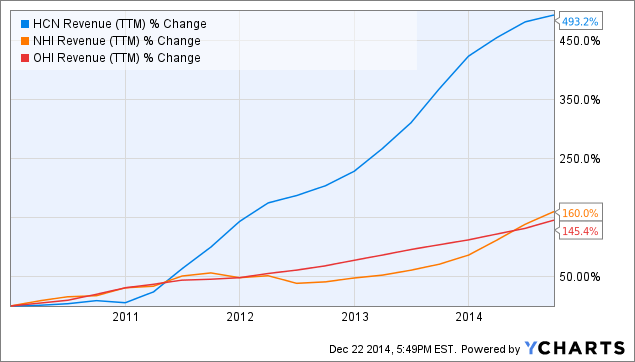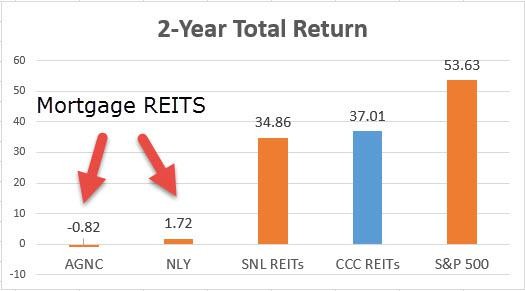Dividend Champions Focus on REITs
Post on: 20 Август, 2015 No Comment

The Dividend Champions spreadsheet and PDF have been updated through 2/28/11 and are available here . N ote that all references to Champions mean companies that have paid higher dividends for at least 25 straight years; Contenders have streaks of 10-24 years; Challengers have streaks of 5-9 years. Together, all of these companies may be referred to using the abbreviation CCC.
This is the second in a series of articles focusing on specific industries and isolating the CCC companies within those industries. The first covered Master Limited Partnerships (or MLPs) and can be found here .
What are REITs?
Real Estate Investment Trusts, or REITs, are specialized companies that are not organized as typical corporations, but instead issue trust units in place of common shares. Adhering to special provisions of the tax code, these are pass-through entities that are not subject to taxation, and instead pass along all of their income and expenses (and responsibility for any taxation) to owners of these trust units. Here is a brief description.
Note that the criteria for maintaining REIT status requires that the company distribute at least 90% of its profits to unit holders. REITs generally own and manage specific types of property, such as apartments, shopping centers, or office buildings, but many REITs manage more than one category, and some REITs do not own property at all, instead attempting to profit from financing arrangements related to real estate. A good source of industry-wide information can be found here.
Technically, REITs do not declare dividends, but instead make distributions, generally on a quarterly basis. Because REITs do not pay taxes, their distributions are not qualified to be taxed at the favorable 15% rate that is available for typical common stock dividends. But while the dividend portion of REIT’s distributions are taxed at the individual investor’s ordinary tax rate, portions of the distribution do receive favorable tax treatment. Essentially, REIT distributions are composed of three elements:
Dividends, which represent the operating income of the company. Since the company is not taxed, its dividend will be taxed at investors’ ordinary (or marginal) tax rates.
Capital Gains Distributions, which come from the sale of income-producing properties. Like the Capital Gains that investors realize when selling stocks, these are taxed at the favorable 15% rate for most taxpayers.
Return of Capital, which is essentially the original cost of properties that were sold by the REIT (and produced the capital gains). Return of Capital is not taxed immediately, but should be used by the investor to reduce his or her cost basis, since it is literally a return of a portion of the individual’s investment. Although there is no immediate taxation, the reduction of the cost basis means that the investor will enjoy larger capital gains (or smaller capital losses) when he or she eventually sells the holding.
A good illustration of the three-part nature of REIT distributions can be seen at the website of HCP Inc. [HCP], formerly named Health Care Properties, which can be found here. As you can see, the level of Return of Capital (which HCP terms Nontaxable Distribution) can vary greatly from year to year, and a REIT can use that variation to ensure that its total distributions increase over time.
The Nuisance Factor
Many potential REIT investors are deterred by confusion over the nature (and tax implications) of the distributions. But a basic understanding of the three elements of the distribution (and their tax treatments) should ease that concern. Unlike MLPs, which issue a K-1 form, REIT investors receive the more familiar 1099 forms that stock owners receive at the end of each year. The main difference is that the dividends are non-qualified (for the 15% rate) and there are typically Capital Gains Distributions and Return of Capital, as mentioned above. (Note that this article does not intend to offer tax advice, and it should not be considered authoritative in that area.)

Because portions of the distribution may be taxed at higher or lower rates than those of common stocks, many advisors suggest that REITs should not be owned in a tax deferred (retirement) account, simply because doing so may fail to take advantage of favorable taxation, effectively turning low-tax income into income that will be taxed at ordinary rates upon withdrawal.
The knock against owning REITs in retirement accounts has some validity, but, like the argument for MLPs, the general notion that doing so would waste any tax advantages may be overblown for two reasons. First, the idea of turning low-tax income into income taxed at ordinary rates (on withdrawal) also applies to other potential investments, including stocks, so if the investor eliminates such investments from consideration in his or her retirement accounts, then that person may be left with very few alternatives.
More important, of course, is owning assets that will grow as much as possible, no matter what the tax rate may eventually be on withdrawal. and that rate may actually be lower than their current marginal rate. The second reason not to be dissuaded revolves around practicality. Given the increased use and funding of 401k, IRA, and other retirement accounts, potential investors may not even face a choice of whether to own something in taxable or tax-deferred accounts. If all your investable cash is in a 401k or Roth IRA, then the choice is simple.
The Companies
The bad news is that there are fewer Champion REITs than was once the case. During the real estate collapse of a few years ago, many REITs saw fit to reduce their distributions, so they had to be deleted from the Champions list (or never were added). For example, UDR Inc. (originally United Dominion Realty) cut its distributions in 2009, ending a 32-year streak of higher payouts. But those that remain stand out as the cream of the crop of distribution-increasing REITs and have proven their fundamental soundness by continuing their streaks.
So there are (still) four Champions and nine Contenders among the 17 REITs that have increased distributions for at least five straight years. As you can see from the listing below, there is also a good amount of diversity by property type among the REITs listed. (I’ve shortened up the Industry and Name columns due to table width concerns, but the industry shown is the primary property type operated by the REIT; it may also own other types.)
Unfortunately, because of the nature of their earnings and distributions (REITs are typically measured by FFO, or Funds From Operations, rather than Earnings Per Share), traditional measures like the Price/Earnings ratio, the Payout Ratio, and the PEG Ratio are too high to be comparable to other companies, so I’m showing Market Cap, which may be a good indication of the financial stability of the REITs shown, along with the percentage variation from each security’s 52-week high and low. Note that most are trading close to their highs, but that’s typical of the current market environment. Because their revenue and income comes from tenant occupancy, REITs reflect the overall economic conditions that drive the fortunes of their tenants to a certain degree, and recovery/expansion of the real estate market and overall economy should benefit them through increased occupancy and the signing (or renewal) of long-term leases.














